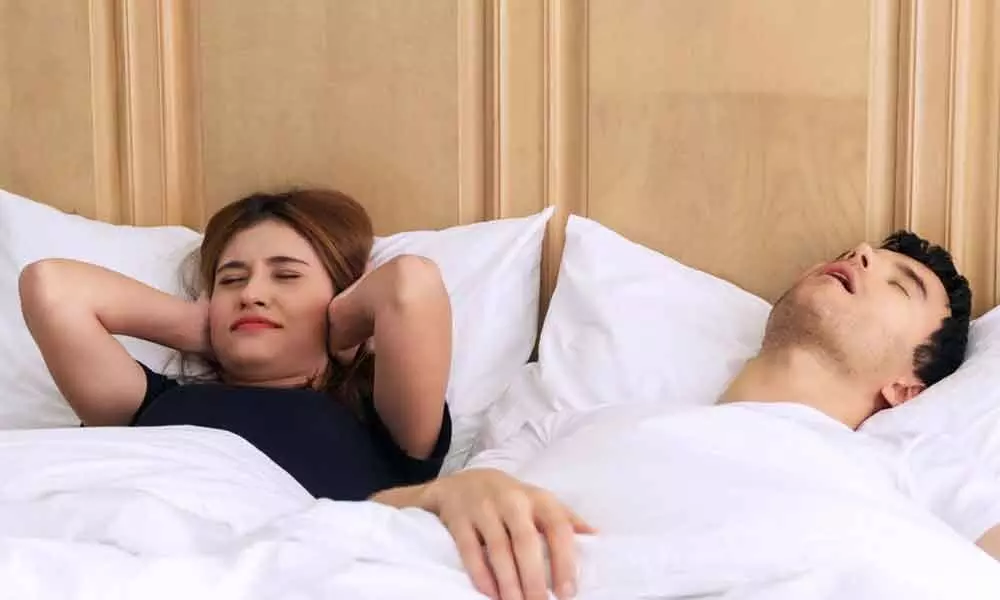The nose, snoring and obstructive sleep apnoea

Representational Image
The noisy sounds of snoring occur when there is an obstruction to the free flow of air through the passages at the back of the mouth and nose.
What is snoring?
The noisy sounds of snoring occur when there is an obstruction to the free flow of air through the passages at the back of the mouth and nose. This area is the collapsible part of the airway where the tongue and upper throat meet the soft palate and uvula. Snoring occurs when these structures strike each other and vibrate during breathing.
In children, snoring may be a sign of problems with the tonsils and adenoids. A chronically snoring child should be examined by an otolaryngologist.
What is sleep apnoea?
Sleep apnea is a serious, potentially life-threatening condition. It is far more common than previously thought. Sleep apnea happens in all age groups and both genders, although it is more common in men.
Sleep apnea is a breathing disorder characterised by brief interruptions of breathing during sleep.
There are two types of sleep apnea:
Central sleep apnea happens when the brain fails to send the appropriate signals to the muscles to start breathing. Central sleep apnea is less common than obstructive sleep apnea.
Obstructive sleep apnea happens when air can't flow into or out of the nose or mouth although efforts to breathe continue.
Sleep apnea is characterized by a number of involuntary breathing pauses or "apneic events" during a single night's sleep. There may be as many as 20 to 30 or more events per hour. These events are usually accompanied by snoring between apnea episodes. But, not everyone who snores has sleep apnea. Sleep apnea may also be characterized by choking sensations. The frequent interruptions of deep, restorative sleep often lead to early morning headaches and excessive daytime sleepiness.
During the apneic event, you can't breathe in oxygen or exhale carbon dioxide. This results in low levels of oxygen and increased levels of carbon dioxide in the blood. This alerts the brain to resume breathing and cause an arousal. With each arousal, a signal is sent from the brain to the upper airway muscles to open the airway. Breathing is resumed, often with a loud snort or gasp. Frequent arousals, although necessary for breathing to restart, prevent restorative, deep sleep.
Early recognition and treatment of sleep apnea is important, as it may be associated with:
• Irregular heartbeat
• High blood pressure
• Heart attack
• Stroke
• Daytime sleepiness
• Increased risk of motor vehicle accidents
Who is at risk for sleep apnea?
People most likely to have or develop sleep apnea include those who:
• Snore loudly
• Are overweight
• Have high blood pressure
• Have some physical abnormality in the nose, throat, or other parts of the upper airway
• narrowed airway – enlarged tonsils and adenoids in children
• thick neck circumference
• Use of alcohol and sleeping pills increases the frequency and duration of breathing pauses in people with sleep apne
What are the symptoms of sleep apnea?
• Loud snoring, which is usually more prominent in obstructive sleep apnea
• Episodes of breathing cessation during sleep witnessed by another person
• Abrupt awakenings accompanied by shortness of breath, which more likely indicates central sleep apnea
• Awakening with a dry mouth or sore throat
• Morning headache
• Difficulty staying asleep (insomnia)
• Excessive daytime sleepiness (hypersomnia)
• Attention problems
• Irritability
When to see a doctor
Consult a Otolaryngologist if you experience, or if your partner notices any of the following:
Snoring loud enough to disturb the sleep of others or yourself choking or Shortness of breath that awakens you from sleep Intermittent pauses in your breathing during sleep
Excessive daytime drowsiness, which may cause you to fall asleep while you're working, watching television or even driving.
What you can do in the meantime
• Try to sleep on your side.
• Avoid alcohol close to bedtime.
• Avoid sedative medications.
• If you're drowsy, avoid driving.
• Lose weight if overweight
How is sleep apnea diagnosed?
• Diagnosis of sleep apnea is not simple because there can be many different causes. Primary healthcare providers, pulmonologists, neurologists, or other healthcare providers with specialty training in sleep disorders may be involved in making a diagnosis and starting treatment. Several tests are available for evaluating sleep apnea, including:
• Polysomnography. This test records a variety of body functions during sleep, such as the electrical activity of the brain, eye movement, muscle activity, heart rate, respiratory effort, air flow, and blood oxygen levels.
• Sleep endoscopy.
How is sleep apnea treated?
For milder cases of sleep apnea, your doctor may recommend only lifestyle changes,
If these measures don't improve your signs and symptoms or if your apnea is moderate to severe, a number of other treatments are available.
• Continuous positive airway pressure (CPAP).
• Oral appliances. Dental appliances that reposition the lower jaw and the tongue have been helpful to some people with mild sleep apnea
• Surgical procedures
• Some people with sleep apnea may need surgery. Examples of these procedures include:
• Surgical procedures to remove adenoids and tonsils, nasal polyps, or other growths or tissue in the airway, or to correct structural deformities may be done.
• Uvulopalatopharyngoplasty (UPPP) is a procedure used to remove excess tissue at the back of the throat (tonsils, uvula, and part of the soft palate). This can be done using coblator or Laser.
• Surgical reconstruction for deformities of the lower jaw may benefit some people.
• Surgical procedures to treat obesity are sometimes recommended for a person with sleep apnea who is obese.
(The writer is Principal Consultant, ENT & Cochlear Implant, BLK Super Speciality Hospital.)
















